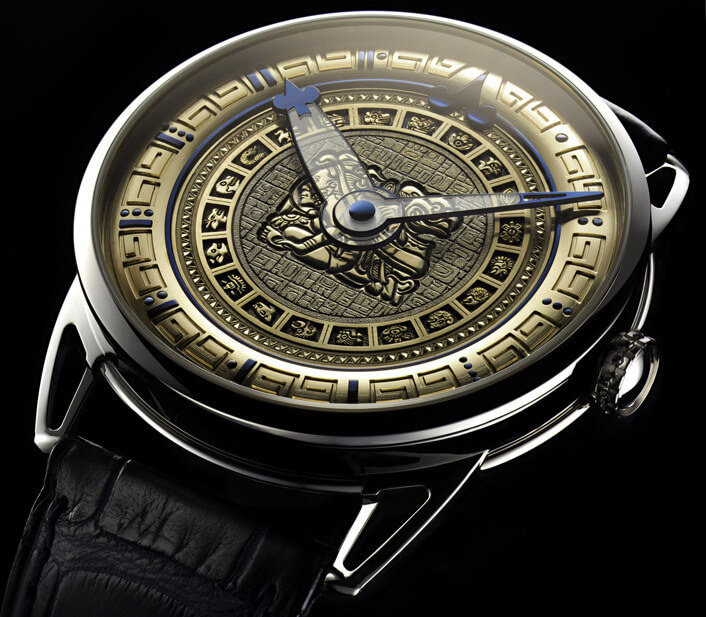Denis Flageollet, co-founder with David Zanetta of De Bethune, saved the best for last. “For the past ten years, at De Bethune we’ve sought to challenge the status quo, not least through a cutting-edge research division but without ever detracting from the science we inherited from our ancestors. The DB 25 Maya is the perfect illustration, in terms of mechanisms but also the métiers d’art.” For this timepiece, Denis Flageollet looked to the Mayan civilisation, one of the first to project itself far ahead in time with a calendar that is making headlines this year. The Maya divided time into underworlds of 400 years each, the last ending in 2012. This watch’s gold dial is directly inspired by these calculations. It is hand-engraved by Michèle Rothen with a mastery that leaves the observer speechless with admiration. Twelve unique watches, each different but sharing a common spirit, will be made.
The extra-terrestrial Dream Watch IV
That the four millenniums of the Mayan calendar should be nearing an end hasn’t prevented De Bethune from investing in the future and unveiling its Dream Watch IV, a teaser for which was revealed last year. This intergalactic bauble is now ready for launch as a limited edition of 12, all of which have found takers. The gamble has clearly paid off for this futuristic iPhone case in polished titanium. The embedded watch dial can be removed and carried in the pocket, or worn on the wrist as the fancy takes.
“The idea was to reinvent our grandfathers’ pocket watch,” says Denis Flageollet. “Three aspects of this piece required particular attention. First the polishing, which is a genuine headache on such an expanse of titanium. Then the iPhone case which is a mechanism in itself. Lastly, how to embed the watch using the case middle. This is precisely the role we expect our Dream Watches to play; to move forward every aspect of our research in ways that will benefit our watches in production. In a word, to perpetuate everything we have achieved since the beginning.”

High frequency résonique
On the subject of achievements, De Bethune recently presented the latest advances made in research launched two years ago to overcome the well-documented limitations of the traditional lever escapement. “Our aim was to eliminate its defects, such as sensitivity to shocks and friction. To make a rather simplistic comparison, it’s as though an athlete, instead of running 400 metres back and forth between two walls, could release all his energy on a normal track. Ultimately though, the options were fairly limited given our aim to free oscillation from constraints.” De Bethune chose what might appear to be the easiest solution: to synchronise an acoustic resonator and a magnetic escapement rotor.
Unlike TAG Heuer’s Pendulum which worked on the magnetic regulation of energy, De Bethune focused on the distribution of energy with the objective of taking frequencies well beyond current standards: theoretically up to 1,000 Hz and currently developed for frequencies within a range of 100 to 200 Hz for a power reserve of 24 to 36 hours. “We’ve started talking about this project because we now know this technology can be applied, and that we are capable of producing a résonique watch. This is an important project for us. No patents have been filed. Instead, we’ve adopted an open-source model with the firm hope of sharing the advanced physics and mathematics that résonique demands.” From the Maya to résonique, De Bethune has come a long way.
















